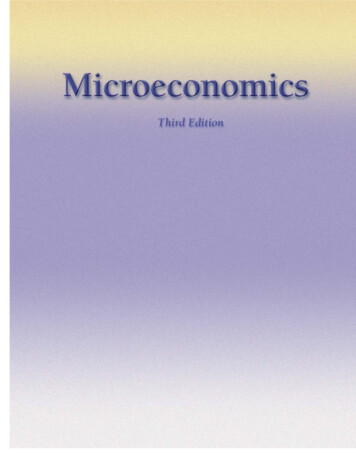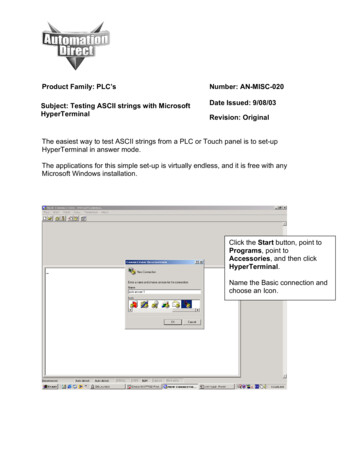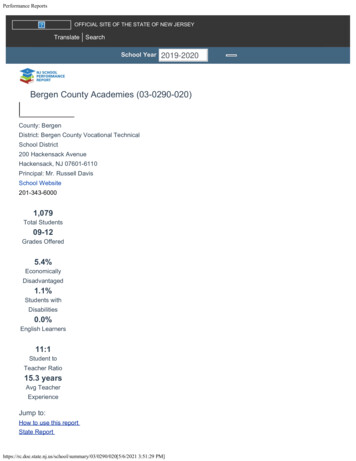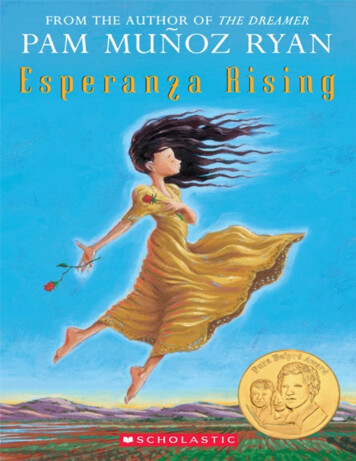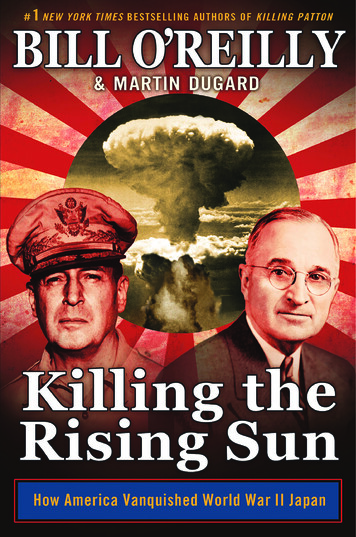
Transcription
ALSO BY BILL O’REILLY AND M ARTIN DUGARDKilling LincolnKilling KennedyKilling JesusKilling PattonKilling Reagan020-65700 ch00 RRDH 5P.indd ii7/8/16 2:45 PM
Killing theRising SunHow America Vanquished World War II JapanBILL O’REILLYandMARTIN DUGARDHenry Holt and CompanyNew York020-65700 ch00 RRDH 5P.indd v7/8/16 2:45 PM
Henry Holt and Company, LLCPublishers since 1866175 Fifth AvenueNew York, New York 10010www.henryholt.comHenry Holt and are registered trademarks ofHenry Holt and Company, LLC.Copyright 2016 by Bill O’Reilly and Martin DugardAll rights reserved.Distributed in Canada by Raincoast Book Distribution LimitedLibrary of Congress Cataloging-in-Publication DataNames: O’Reilly, Bill, author. Dugard, Martin, author.Title: Killing the rising sun : how Amer ica vanquished World War II Japan /Bill O’Reilly and Martin Dugard.Description: First edition. New York : Henry Holt and Company, 2016. Includes index.Identifiers: LCCN 2016018160 ISBN 9781627790628 (hardcover : alk. paper) ISBN 9781627790635 (electronic book)Subjects: LCSH: World War, 1939–1945— United States. World War,1939–1945— Japan. World War, 1939–1945— Campaigns— Pacific Area. Pacific Area— History, Military—20th century.Classification: LCC D767 .O74 2016 DDC 940.54/260973— dc23LC record available at https:// lccn.loc.gov/2016018160ISBN: 978-1-62779-062-8Our books may be purchased in bulk for promotional, educational, or business use.Please contact your local bookseller or the Macmillan Corporate and Premium SalesDepartment at (800) 221-7945, extension 5442, or by e-mail atMacmillanSpecial Markets@macmillan.com.First Edition 2016Designed by Meryl Sussman LevaviPrinted in the United States of Amer ica13579108642H020-65700 ch00 RRDH 5P.indd vi7/8/16 2:45 PM
This book is dedicated to all World War II veterans.Freedom rings because of you.020-65700 ch00 RRDH 5P.indd vii7/8/16 2:45 PM
The land of the rising sun—A NCIENT CHINESE DESCRIPTION OF JAPAN,REFERRING TO THE MORNING SUN’S REACHINGTHE ISLANDS OF JAPAN BEFORE THE ASIAN MAINLAND020-65700 ch00 RRDH 5P.indd ix7/8/16 2:45 PM
020-65700 ch00 RRDH 5P.indd x7/8/16 2:45 PM
Killing theRising Sun020-65700 ch00 RRDH 5P.indd xi7/8/16 2:45 PM
A NOTE TO READERS On September 16, 2001, five days after the savage attack launchedby Al Qaeda terrorists on the United States, Barack Obama’slongtime Chicago pastor, Reverend Jeremiah Wright Jr., delivered a stunning anti-American diatribe in his church. Listing whathe believed to be atrocities America had committed in the past thatwould explain or perhaps justify the 9/11 mass murder, Wright gotaround to condemning his country for dropping two atomic bombson Japan in 1945.“We bombed Hiroshima. We bombed Nagasaki. And we nukedfar more than the thousands in New York and the Pentagon. . . .Amer ica’s chickens are coming home to roost.”Seven years later, Wright’s explosive statements were uncoveredby the media. Senator Obama, then campaigning to become president, quickly repudiated his pastor’s assessment, distancing himselffrom the militant minister who officiated at his wedding and withwhom he had a close relationship for about twenty years.It is safe to say that many people around the world had little orno idea what Wright was talking about. Sure, most folks know thatA-bombs were dropped and the carnage caused was catastrophic.But, sad to say, the events leading up to the end of World War II020-65700 ch01 RRDH 5P.indd 17/8/16 2:44 PM
2 Bill O'Reilly and Martin Dugardare not that widely known anymore. Thus, statements like the oneWright made sometimes go unchallenged.Every person on this planet lives with a common threat: nuclearannihilation. The nuclear weapons of today dwarf the first A-bombsin destructive power. Currently, the Iranian nuclear treaty has raisedawareness of the threat, but still, the nuclear bomb’s origins and thebrutal world of the mid-1940s are no longer common knowledge.Enter this book. It comes with a warning: the followingpages contain some extremely troubling material. The violence theworld witnessed in 1945 is unprecedented in history and will bechronicled on the following pages in detail.What Martin Dugard and I are about to tell you is true andstark. The way the United States defeated the Japa nese empire isvital to understand because the issues of that war are still beingprocessed throughout the world today.Killing the Rising Sun is the sixth in our series of history books.We believe you will know far more about Amer ica by the book’send. We also believe you will be very able to put the comments ofpeople like Reverend Wright in their proper context.We live in a time of spin and deception. It is impor tant to knowthe truth.Here it is.BILL O’REILLYLong Island, New YorkMarch 2016020-65700 ch01 RRDH 5P.indd 27/8/16 2:44 PM
INTRODUCTION OVAL OFFICE, THE WHITE HOUSEWASHINGTON, DCOCTOBER 12, 193910:00 A.M.The age of mass destruction is about to dawn.“What bright idea do you have now?” an upbeat FranklinDelano Roosevelt asks Wall Street financier Alexander Sachs,one of his key advisers on the New Deal that lifted Amer ica out ofthe Great Depression. The forty- six-year- old economist sits on theopposite side of the president’s massive wooden desk. FDR wasup past midnight, as is his custom. The deep circles under his eyesand his pale skin, resulting from constant exhaustion and too littletime spent outdoors, make the president look far older than hisfifty-seven years. His health is not enhanced by the Camel cigarettehe now holds, one of the more than twenty he will smoke today.Sachs chooses his reply carefully. This meeting is so top secretthat it will not appear in the official daily log of presidential appointments. Sachs can only hope that it will go better than the hour hespent with Roosevelt yesterday, when he labored unsuccessfully to020-65700 ch01 RRDH 5P.indd 37/8/16 2:44 PM
4 Bill O'Reilly and Martin Dugardfind the right words to describe what could possibly be the greatest single threat to mankind.It has been six weeks since Nazi Germany invaded Poland,beginning what will become known as the Second World War. Onemonth prior, on August 2, theoretical physicist Albert Einstein wrotean urgent letter to President Roosevelt warning “that it may becomepossible to set up a nuclear chain reaction in a large mass of uranium . . . extremely powerful bombs of a new type may thus be constructed.”Einstein is a longtime friend of Roosevelt’s, but he felt that sending Alexander Sachs to deliver the letter in person would be themost effective way of getting his point across. Yet when Sachsfinally managed to get an audience with Roosevelt yesterday morning, the pompous financier was unable to articulate his case.Rather than simply reading Einstein’s two-page letter aloud, heappeared in the Oval Office with a stack of technical papers detailing Amer ica’s uranium output and then read from an eighthundred-word summary he had written. Sachs never mentionedthat Einstein and other top American scientists believe that the newbombs could obliterate entire cities—or that Nazi Germany is currently racing to build such weapons. Roosevelt grew bored asSachs droned on. With pressing business to address, the presidentdismissed Sachs, telling him to come back the next day.That time is now. Realizing his mistake, Sachs gets right downto business. As Roosevelt listens attentively, the Wall Street leaderreads Einstein’s letter aloud. The president may not have appearedto be listening yesterday, but some of the discussion seems to havesunk in. Roosevelt probes Sachs with questions about uranium,the Nazis, and this new bomb. Einstein’s letter makes it clear thatthe Germans have already taken control of a key uranium minein Czechoslova kia and that scientists at the Kaiser WilhelmInstitute in Berlin are attempting to use this uranium to set up anuclear chain reaction that could lead to the most lethal bomb inhistory.Roosevelt has finally heard enough. “Alex,” he summarizes for020-65700 ch01 RRDH 5P.indd 47/8/16 2:44 PM
Killing the Rising Sun 5the financier, “what you are after is to see that the Nazis don’t blowus up.”“Precisely,” a relieved Sachs answers.Roosevelt immediately summons his personal secretary, retiredUS Army general Edwin “Pa” Watson, into the Oval Office.“Pa,” Roosevelt orders, “this requires action.”020-65700 ch01 RRDH 5P.indd 57/8/16 2:44 PM
1 PELELIU, CAROLINE ISLANDSPACIFIC OCEANSEPTEMBER 15, 19440832 HOURSDestruction is near for the empire.The morning heat is so unbearable that Corporal LewisKenneth Bausell, USMC, has trouble breathing. He is huddledinside an amphibious landing vehicle with a dozen other marines ofthe First Battalion, headed for the section of Japanese-held beachcode-named Orange One. Even this early in the morning, the temperature hovers at 100 degrees. The Americans are sweating profusely as their armored craft brings them ever closer to the sand. Butheat is not the only factor—some of the perspiration is from nerves.These marines understand that they may soon die or be maimed forlife and few will ever know what happened to them.Unlike in the much more publicized war in Eu rope, wherereporters like Ernie Pyle and Edward R. Murrow are making namesfor themselves by covering every aspect of the fighting, there are nojournalists or photographers hitting this remote beach today. The020-65700 ch01 RRDH 5P.indd 77/8/16 2:44 PM
020-65700 ch01 RRDH 5P.indd 87/8/16 2:44 PM
Killing the Rising Sun 9crucial upcoming battle against the Japanese will be waged in nearanonymity.Peleliu is important because of its airstrip, a hard-surfaced fieldcapable of launching long-range fighter-bombers. The island is justsix miles long and two miles wide, but the terrain is exceptionallyrugged, a film of thin soil laid atop coral and limestone. A thousandyards off the beach rise the jungle- covered Umurbrogol ridges, aseries of low, jagged peaks forming the island’s spine. The Japanesehave long coveted tiny, remote Peleliu, first taking possession of theempty island in 1914. For two decades it remained basically unused,but with the war came renewed awareness of its tactical importance.Since this past summer, knowing that the Americans would soonattack, the Japanese have labored to transform Peleliu into a fortress.Most American marines could not care less about the historyof Peleliu. Each man approaches the coming battle in his own way.Some smoke to calm their fears, some vomit onto the steel deck,and others worry about wetting their pants. But there is one beliefthat every man shares: no matter what happens when they hit thebeach, surrendering to the enemy will not be an option.Lewis Bausell has been through this before. Only twenty yearsold, the apprentice bookbinder from Washington, DC, has an easysmile and a wide boxer’s nose. His hair is cropped close to his skull.Bausell had a semester left at McKinley Technical High School whenthe Japanese bombed Pearl Harbor in December 1941. He immediately dropped out of school and tried to enlist in the navy but wasrejected. So instead, he enlisted in the Marine Corps. During hismore than two years serving his country, Bausell has earned therespect of his peers, and although his rank is not yet official, justone month ago Bausell was selected for promotion to the rank ofsergeant because of his heroic performance and leadership duringinvasions on Tulagi, Gavutu, Guadalcanal, and Cape Gloucester. TheAmerican military campaign in the Pacific followed a strategy known as“island hopping.” The US Navy, Army, and Marine Corps invaded Japanese islandstrongholds in the Pacific, slowly working their way north toward an eventualinvasion of Japan. Islands not deemed vital to the advance were bypassed.020-65700 ch01 RRDH 5P.indd 97/8/16 2:44 PM
10 Bill O'Reilly and Martin DugardNow, as the amtrac churns forward through the flat surf towardPeleliu, Bausell buckles the chin strap of his steel helmet. The landingcraft stalls momentarily on the coral reef one hundred yards offshore,then continues churning toward the landing zone. Bausell is temptedto peer up and over the side to glimpse the battlefield, but he keepshis head down. Japanese snipers are known to target the curious.All at once, geysers of water erupt around the landing craft.Incoming Japa nese 141-mm mortar rounds fill the air. Many fi ndtheir mark, killing Bausell’s fellow marines on other landing craft.The explosions and the roar of artillery are so loud that Bausell andhis squadmates cannot hear one another without yelling. The smokeof battle has turned the blue morning sky black. On any other day,Peleliu is a tropical island paradise. Today it is a living hell.Final moments before landing on Peleliu020-65700 ch01 RRDH 5P.indd 107/8/16 2:44 PM
Killing the Rising Sun 11“Hit the beach,” yells a sergeant as the amtrac’s steel treadsreach the shore. Bausell vaults up and over the side, landing hardon the bone-white sand and coral. The staccato chatter of hiddenJapanese machine guns forces Bausell to press his body flat againstthe earth. All around him, explosions bring flashes of light. Thepalm trees lining the beach are in flames. Crimson pools of American blood mingle with the yellow phosphorus of Japanese incendiary devices.“All any man could do was sweat it out and pray for survival,”one marine will later write of his first moments on Peleliu. “It wouldhave been sure suicide to stand up during that firestorm.”Every thing Bausell sees and hears gives the lie to what he andhis fellow marines had been told about this tactically vital Japanesestronghold. In preparation for Operation Stalemate, the UnitedStates Navy bombarded Peleliu with ten days of aerial raids and twomore days of naval shelling. It seemed impossible that anyone couldhave lived through such an intense barrage of napalm and artillery;“we have run out of targets,” a top naval officer complained. American intelligence supported this notion, suggesting that the enemyresponse would be minimal. The Marine Corps officer commanding the invasion, Major General William Rupertus, predicted aquick and easy battle—“a hard fought ‘quickie’ that will last for fourdays, five days at most.”But as Corporal Lewis Bausell and his squad can now attest,Peleliu will not be taken easily. Its defenders have had months toprepare. Mortar launchers and artillery are concealed behind the2,200-yard beachfront, targeted to strike the precise spots at whichthe Americans now race ashore. In addition, the Japa nese haveconstructed antitank barriers, laid hundreds of mines, and linedthe beach with every coil of barbed wire in the Caroline Islands.“Spider traps”— machine- gun nests made of coconut- tree logs—are camouflaged so well that they are almost invisible in the swampylandscape where jungle meets the sand.Yet Japanese commander Colonel Kunio Nakagawa is a realist. He knows the Americans will eventually work their way ashore.020-65700 ch01 RRDH 5P.indd 117/8/16 2:44 PM
12 Bill O'Reilly and Martin DugardThe US force is huge. So the wily colonel is employing a strategytried just once before in the war. Despite the horrific welcome theAmericans are now receiving, it is not his goal to win this battle onthe beaches. Just a fraction of his army now fights the marines, butthousands of other elite troops wait inland, in a network of fivehundred hidden caves in the nearby Umurbrogol highlands.These fukkaku defenses will allow Nakagawa and his men tocounter the Americans, “bleeding them white” by coming out ofhiding to attack when the marines least expect it.The attacking Japanese soldiers’ ability to swarm out of nowhereled top British general William Slim to refer to them as “the mostformidable fighting insect in history.” The men of Nakagawa’sFourteenth Imperial Division embody that sentiment. Almost allare veteran warriors, hardened by years of battle. They have beenliving five stories underground, subsisting on a simple diet of riceand fish and enduring the beatings and harsh discipline from theirofficers that are typical of the Japanese army. “You could be beatenfor anything,” one Japa nese soldier later remembered. “Being tooshort or being too tall, even because somebody didn’t like the wayyou drank coffee. This was done to make each man respond instantlyto orders, and it produced results. If you want soldiers who fighthard, they must train hard.”These soldiers have been taught another crucial lesson: that theJapanese race is superior to all others, and that triumph over theinferior Americans is inevitable.That is a lie.But to soldiers of the Imperial Japanese Army, it doesn’t matter.Their strongest belief of all is in the samurai code of Bushido, which Theconcept of endurance engagements, as opposed to decisive engagements,as a means of fighting a protracted defensive battle to wear down the Americans was initially used on the small island of Biak, off the western coast of NewGuinea. It was unsuccessful there; the Japanese were annihilated during thebattle, losing 6,100 soldiers. The soldiers of the US Army’s Forty-First Division,most of whom hailed from Oregon and Montana, earned the nickname “TheJungleers” for their success in the dense rain forests. They lost fewer than fivehundred men.020-65700 ch01 RRDH 5P.indd 127/8/16 2:44 PM
Killing the Rising Sun 13stipulates that surrender is a form of dishonor. “The man whowould not disgrace himself must be strong,” reads a line from theJapanese army’s Senjinkun, a pocket- size code of behav ior issuedto all ser vicemen. “Do not survive in shame as a prisoner. Die, toensure that you do not leave ignominy behind you.”Therein lies the basis for Colonel Nakagawa’s trap.There is no escape route for the Japanese, no evacuation plan.The forty- six-year- old Nakagawa, who was decorated nine timesfor his heroism during Japan’s earlier war with China, has alreadyinformed his wife that he will never see her again.Soon, very soon, he will lure the unsuspecting Americans intothe Umurbrogol highlands and slaughter them.But in turn, he and his men will also be slaughtered.Surrender is not an option.Corporal Lewis Bausell rises up off the sand and sprints in a lowcrouch. His goal is the protective shelter of a small coral ridge ahundred yards inland. All around him as he runs, shouts of “Getthe hell off the beach!” mingle with desperate pleas of “Corpsman!”Bausell has never seen such destruction. Two hundred marines willdie today; hundreds more will be wounded. Terrified corporals andprivates now watch the bodies of their brother marines torn apartas fire from Japanese heavy artillery crashes down.“One figure seemed to fly to pieces,” a marine will recall of aparticularly grisly death. “With terrible clarity I saw the head andone leg fly into the air.”“I saw a wounded Marine near me staggering,” another American will remember. “His face was half bloody pulp and the mangled shreds of what was left of an arm hung down like a stick . . . hefell behind me, in a red puddle on the white sand.”Every man here knows what the Japanese army does to prisoners of war. Rather than hold men captive, the Japanese murder themin the most heinous fashion. Veterans of previous battles with thisenemy have seen the corpses of marines unlucky enough to be020-65700 ch01 RRDH 5P.indd 137/8/16 2:44 PM
14 Bill O'Reilly and Martin Dugardtaken alive. Some had their bodies roped to a tree and used for livebayonet practice. Some had their heads, arms, and legs choppedoff; scores of US Marines were emasculated with bayonets as theylay dying on the ground.“It was kill or be killed,” Marine Corps private Dan Lawler willlater remember. “The Japs didn’t take prisoners so we didn’t takeprisoners either.”Or, as Marine Corps colonel Lewis “Chesty” Puller ordered hismen before the Peleliu invasion: “You will take no prisoners. Youwill kill every yellow son- of-a-bitch, and that’s it.”It seems an eternity, but it is only an hour before Corporal Bauselland a few of his fellow marines manage to get off the sand. Bausell’ssmile has been replaced by a tight-lipped glare. His instincts sharpened by his many previous landings, Bausell searches the tree linefor signs of hidden enemy machine-gun emplacements targeting theinvasion force. Suddenly, a burst of light gets Corporal Bausell’sattention. The Japanese machine guns fire tracer bullets to help themzero in on a target, but these illuminated rounds can also help themarines pinpoint the shooter’s precise location. Bausell sees a streamof tracers emerging from a small cave with a commanding view ofthe beach. The entrance is concealed by scrub plants and thickbrush.Taking charge of the squad, he motions for his men to followhim toward the cave’s location. Reaching the cave first, he fires intoa small opening. Lieutenant Jack Kimble of Greenville, Mississippi,arrives with a two-man flamethrower team; a stream of fi re islaunched into the Japanese position in the hope of forcing the enemyto come out. Corporal Bausell, meanwhile, stands ready to shootthem as they emerge.The first Japanese to run screaming from the cave is carry ing agrenade. He pulls the pin before Bausell can fire his M1 carbine.Not only does the explosion kill the Japa nese soldier but shrapnelslices into several nearby marines.020-65700 ch01 RRDH 5P.indd 147/8/16 2:44 PM
Killing the Rising Sun 15More flame is shot into the cave. Another Japa nese soldieremerges.This time, Bausell shoots him dead.Yet another Japanese soldier runs out of the cave, choosing thesure death by rifle fire to being roasted alive. He too carries a grenade, hurling it at the Americans as Bausell raises his weapon.The grenade is launched before Bausell shoots; it lands nearhim and several other marines. The blast may kill them all.Without hesitation, Corporal Bausell throws his body onto thegrenade. His torso rises off the ground as it explodes, smotheringthe blast. None of his fellow marines is hurt.“Get that Jap,” Bausell shouts. Somehow, he is still alive.The flamethrower team shoots off a burst of flame, turning theJapanese soldier into a human torch.Less than two hours after landing on Peleliu, Corporal LewisBausell is put on a stretcher and carried back down the beach. Heis loaded aboard an amtrac, then ferried out to the hospital shipBountiful, where he is immediately taken into surgery.But doctors cannot stop the bleeding. The Japanese grenade hassent deadly shards of metal deep into Bausell’s internal organs. OnSeptember 18, 1944, three days after the invasion of Peleliu, Corporal Lewis Bausell dies.Unlike those of soldiers fighting on World War II’s Europeanfront, his body will not be lowered into the ground and marked witha monument so that his family might someday visit. Instead, hiscorpse is wrapped in sailcloth, tethered to a spent artillery shell,and dropped at sea.Corporal Lewis Bausell is the first United States Marine at theBattle of Peleliu whose death will see him awarded America’s highest award for valor, the Medal of Honor, for actions above andbeyond the call of duty in combat.He is not the last.020-65700 ch01 RRDH 5P.indd 157/8/16 2:44 PM
Killing the Rising Sun is the sixth in our series of history books. We believe you will know far more about Amer i ca by the book’s end. We also believe you will be very able to put the comments of people like Reverend Wright in their proper context. We live in a time of spin and d
